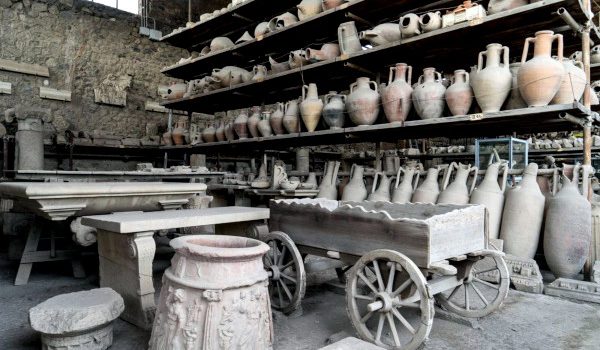Special Visit to the Forum Granaries from the 7th July
Amphorae, terracotta pottery, small and large containers used for the transport and trade in foodstuffs and much more. An immersion amidst the many objects of everyday life and trade at Pompeii. All will be revealed in the special visit to the deposits of Pompeii, housed in the ancient Forum granaries, which from July will open to the public for the first time.
From the 7th July, every Wednesday during July and August between 10:00 and 12:00 and 14:00 and 16:00, it will be possible to request a guided visit conducted by Park staff. Prior booking is advised via the www.ticketone.it site. It is also possible to purchase tickets at the Porta Marina Ticket Office.
The cost of the visit will be €3 (+€1.50 online advance sale fee), in addition to the site entrance ticket. Visits are restricted to groups of a maximum of 10 people every half hour.
Visits to the granaries will also be possible in the evening at a cost of €5, in addition to the site evening entrance ticket, on the following Fridays and Saturdays - the 6th and 7th, and 27th and 28th August, as well as the 3rd and 4th, 10th and 11th, and 25th September - using the same methods of booking.
The granaries/deposits face onto the western side of the Forum, with eight openings separated by brick pillars, and possibly served as a fruit and vegetable market. Today they form the most important archaeological warehouse of the city, and house more than nine thousand finds unearthed by the excavations which have been conducted at Pompeii and its surroundings since the late 19th century.
They safeguard the terracotta pottery that was used in the last decades of the life of the city for everyday activities, such as pots and stoves used for cooking, as well as jugs, bottles and amphorae - the large containers used to transport oil, wine and fish sauces from across the Mediterranean. Marble tables and basins for fountains which adorned the entrances of the houses are also on display, along with several casts of victims of the eruption, as well as that of a tree.
The building was constructed after the earthquake of AD 62, and was possibly incomplete at the time of the eruption. This structure will become a museum dedicated to the history of the Forum and of the work carried out by craftsmen in the city, where the visitor will be able to see not only the finds but also the casts of the victims, alongside the objects that they carried with them during their escape. (Date of excavation: 1816-1822).


